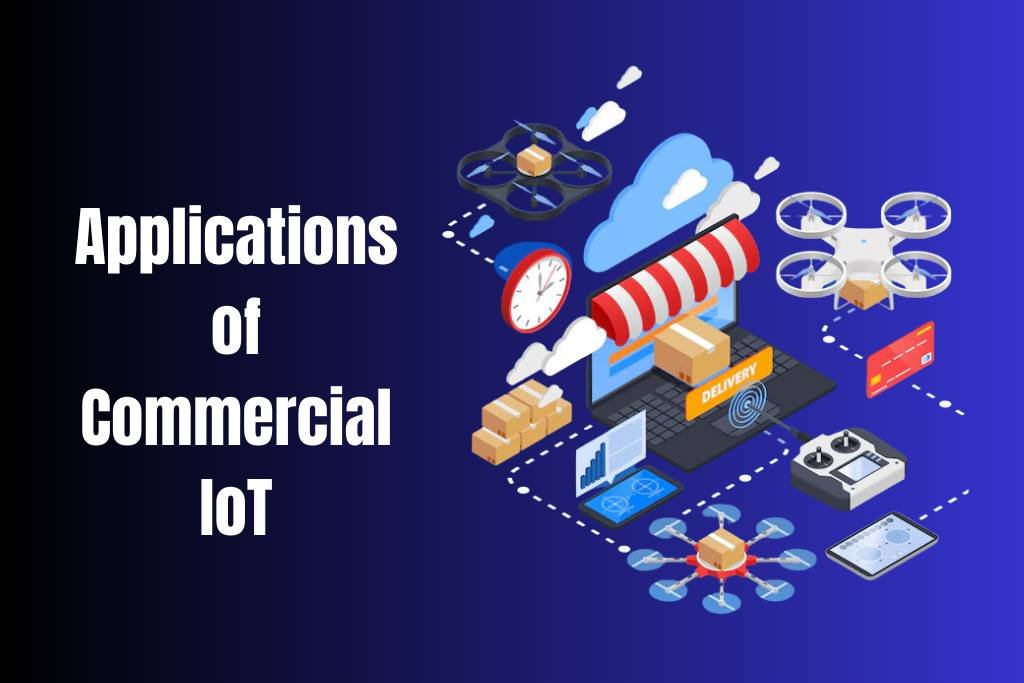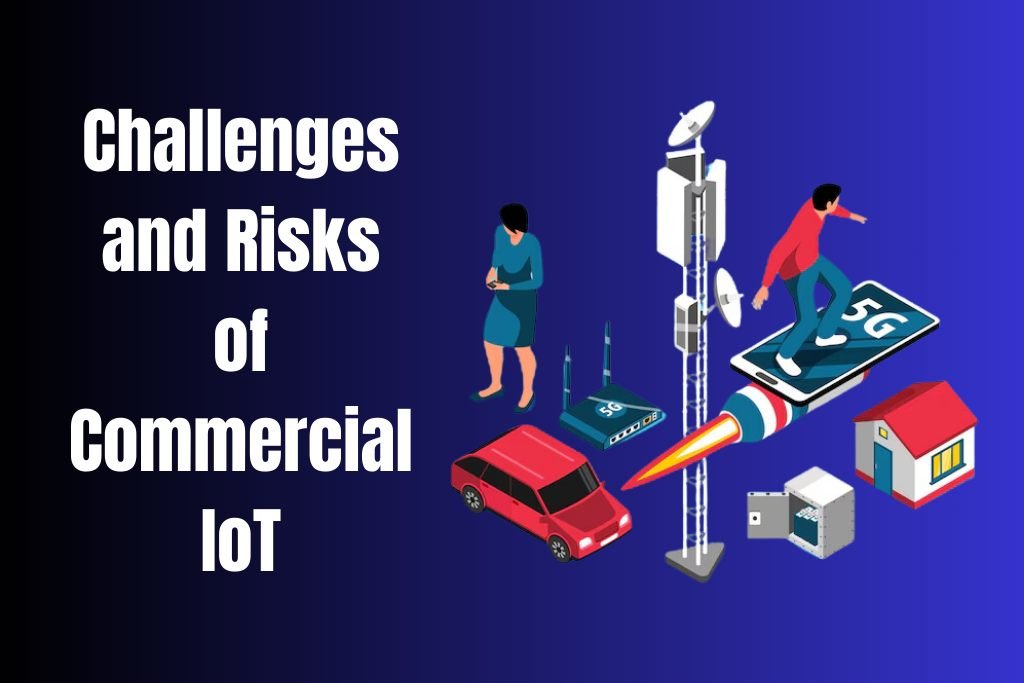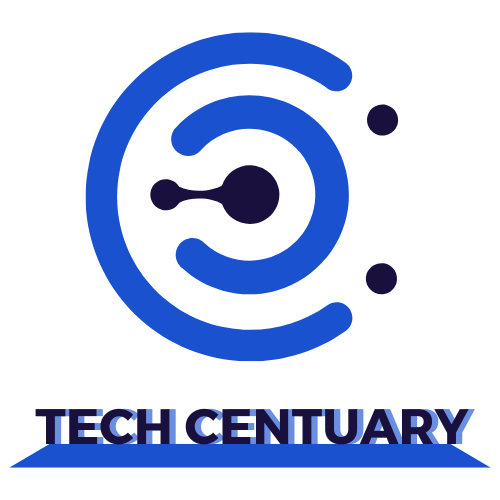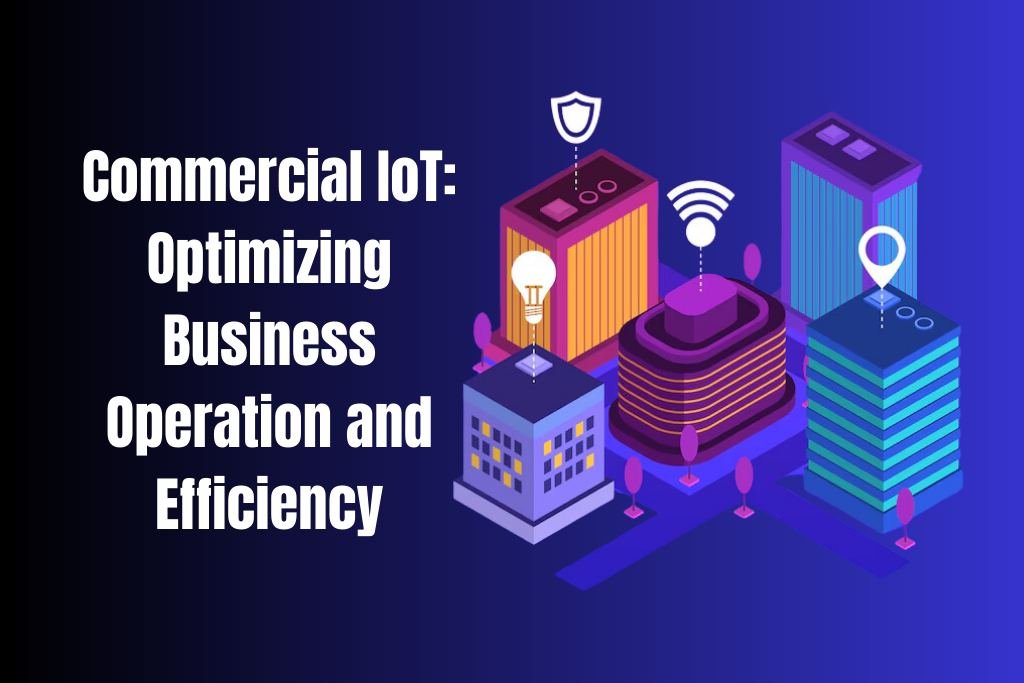Commercial IoT (Internet of Things) integrates connected devices and systems into business operations to improve efficiency, reduce operational costs, and enhance service delivery. This technology enables businesses to gather real-time data, automate processes, and make informed decisions, driving better outcomes across industries like retail, hospitality, healthcare, and real estate.
By leveraging IoT, businesses can optimize inventory management, monitor energy consumption, enhance security systems, and provide personalized customer experiences. This article delves into the mechanics of Commercial IoT, its applications, advantages, challenges, and the trends shaping its future.
Table of Contents
What is Commercial IoT?
Commercial IoT refers to the use of connected devices and technologies specifically designed to improve operational efficiency and service delivery in business environments. Unlike Industrial IoT, which focuses on large-scale production systems, or Consumer IoT, which centers on personal devices, Commercial IoT addresses business needs such as inventory tracking, energy management, and customer engagement.
This form of IoT integrates sensors, connectivity, and data processing to enable businesses to automate processes, optimize resources, and make real-time decisions. Applications span industries such as retail, hospitality, real estate, and healthcare, where IoT-driven solutions offer measurable improvements in cost savings, operational control, and customer satisfaction.
How Commercial IoT Works
Commercial IoT operates by connecting devices and systems to collect, share, and analyze data in real time. These systems rely on three core components:
- Connected Devices and Sensors: Devices such as smart thermostats, cameras, and sensors monitor activities and environmental conditions, collecting data crucial for business operations.
- Connectivity Technologies: Technologies like Wi-Fi, LTE, and 5G enable devices to communicate with each other and with centralized systems seamlessly, ensuring smooth operations.
- Data Processing and Management: Data collected from devices is processed in cloud platforms or through edge computing for faster responses. IoT platforms like AWS IoT or Google Cloud IoT help manage this data efficiently, providing actionable insights.
For example, in a retail store, IoT sensors monitor inventory levels, automatically sending alerts for restocking. In smart buildings, IoT systems control lighting and HVAC based on real-time occupancy data, reducing energy consumption while maintaining comfort.
Applications of Commercial IoT
Commercial IoT has transformed business operations across various sectors by introducing smarter processes and delivering actionable insights. These applications demonstrate the versatility of IoT in driving innovation and efficiency.

Retail
In the retail sector, IoT enables businesses to streamline operations and provide enhanced shopping experiences. Smart shelves equipped with sensors track inventory levels and send alerts when stock runs low, ensuring timely restocking.
Additionally, IoT-powered devices analyze customer behavior, such as foot traffic patterns, allowing retailers to optimize store layouts for improved customer navigation and product visibility. Personalized marketing strategies also benefit from IoT, as connected beacons can send targeted promotions directly to customers based on their location in the store. These innovations collectively enhance both operational efficiency and customer satisfaction.
Hospitality
The hospitality industry leverages IoT to elevate guest experiences and improve operational efficiency. IoT-enabled rooms allow guests to control lighting, temperature, and entertainment systems through mobile apps or voice commands, providing a personalized stay. Smart energy management systems adjust room settings based on occupancy, reducing energy waste in unoccupied rooms.
Moreover, IoT streamlines housekeeping and maintenance tasks by providing real-time updates on room status or identifying equipment issues before they affect guest experiences. By integrating IoT, hotels and resorts can optimize resource utilization while delivering exceptional service.
Real Estate and Smart Buildings
IoT plays a pivotal role in modernizing building management systems (BMS) by improving energy efficiency, security, and maintenance. Smart buildings equipped with IoT sensors monitor lighting, heating, and cooling systems to optimize energy consumption based on occupancy patterns. Security is also enhanced through IoT-powered access control systems, which use facial recognition or mobile credentials to manage entry.
Additionally, predictive maintenance features alert building managers to potential issues with infrastructure, reducing downtime and repair costs. These advancements make IoT essential for creating sustainable and intelligent building environments.
Healthcare
In the healthcare sector, IoT supports better patient care and streamlined operations. Connected devices monitor vital signs and provide real-time data to healthcare providers, enabling proactive interventions. IoT also improves asset tracking, ensuring that critical medical equipment such as infusion pumps or wheelchairs is always available when needed.
Additionally, smart hospital rooms allow patients to control their surroundings, such as lighting and temperature, enhancing comfort and recovery experiences. By integrating IoT, healthcare facilities can achieve higher levels of efficiency and patient satisfaction.
Benefits of Commercial IoT
The adoption of Commercial IoT has brought transformative benefits to businesses across various industries. By enabling real-time data collection and automation, IoT has become a powerful tool for optimizing operations and improving customer experiences.
1. Enhanced Operational Efficiency
Commercial IoT allows businesses to monitor processes in real-time, identify inefficiencies, and make adjustments to improve productivity. For example, connected devices in retail can track inventory levels, ensuring shelves are always stocked without manual intervention. Similarly, in smart buildings, IoT systems automate lighting and HVAC controls, reducing energy waste and cutting operational costs.
2. Improved Customer Experiences
IoT helps businesses tailor their services to individual preferences. In hospitality, guests can personalize their stay by adjusting room settings through mobile apps or voice commands. Retailers use IoT-powered analytics to understand customer behavior and provide personalized product recommendations or targeted promotions. These advancements create a seamless and engaging experience for customers.
3. Cost Savings through Automation
By automating repetitive tasks, IoT reduces the need for manual labor and minimizes errors. Smart energy management systems in buildings lower utility costs by adjusting usage based on occupancy patterns. Predictive maintenance in IoT-enabled systems prevents costly breakdowns by identifying potential issues before they escalate.
4. Real-Time Decision-Making
IoT devices collect and process vast amounts of data in real-time, enabling businesses to make informed decisions quickly. For instance, a logistics company can track shipments and adjust routes in real-time to avoid delays. These capabilities provide businesses with a competitive edge in dynamic markets.
5. Enhanced Security and Asset Monitoring
IoT-enabled security systems improve workplace safety and protect assets. Smart cameras, access controls, and sensors monitor buildings and alert managers to potential breaches or unauthorized access. Asset tracking systems ensure critical equipment is accounted for, reducing theft or misplacement.
6. Sustainability and Resource Optimization
IoT promotes eco-friendly practices by optimizing resource usage. Smart grids and IoT-enabled energy management systems reduce electricity consumption, while automated irrigation systems in commercial properties conserve water. These measures help businesses align with sustainability goals and reduce their environmental footprint.
Challenges and Risks of Commercial IoT
Despite its benefits, the adoption of Commercial IoT comes with challenges and risks that businesses must address to ensure successful implementation.

Data Privacy Concerns
With IoT systems collecting vast amounts of data, businesses must navigate concerns around data privacy and compliance. Sensitive customer information and operational data can be at risk if not properly secured. Ensuring compliance with regulations such as GDPR or CCPA is essential to building trust and avoiding penalties.
Security Vulnerabilities
IoT devices are often targeted by cyberattacks due to their interconnected nature. Without robust security measures, these devices can be exploited, leading to data breaches or unauthorized access. Businesses must implement encryption, regular software updates, and multi-factor authentication to mitigate these risks.
Integration Challenges
Integrating IoT with existing systems can be complex, especially in businesses relying on legacy infrastructure. Ensuring compatibility between new IoT devices and older technologies requires careful planning and investment, which can delay implementation.
High Initial Costs
The upfront costs of deploying IoT systems can be significant, including the expense of purchasing devices, installing infrastructure, and training employees. Small and medium-sized businesses may face financial constraints when adopting IoT solutions.
Dependence on Reliable Connectivity
IoT systems rely heavily on stable and fast internet connections. Any disruptions in connectivity can hinder the performance of IoT devices, affecting operations and customer satisfaction. Businesses must invest in reliable network infrastructure to support seamless IoT integration.
Emerging Technologies in Commercial IoT
Emerging technologies are driving advancements in Commercial IoT, making systems smarter, faster, and more reliable. These innovations are shaping the future of IoT in business environments by addressing challenges and unlocking new possibilities.
1. Artificial Intelligence (AI)
AI is a game-changer for Commercial IoT. It enables devices to analyze data, detect patterns, and make predictions, allowing businesses to optimize processes and enhance decision-making.
- Predictive Analytics: AI processes IoT data to anticipate equipment failures or demand fluctuations, helping businesses avoid downtime.
- Customer Insights: AI-powered IoT systems analyze consumer behavior, enabling businesses to personalize marketing and improve customer experiences.
2. 5G Connectivity
The rollout of 5G networks has significantly enhanced IoT performance by offering higher speeds and lower latency. This enables real-time communication between IoT devices, crucial for applications like smart security systems and automated processes.
For example, in retail, 5G allows for instant updates on inventory levels and faster responses to customer demands.
3. Edge Computing
Edge computing processes data closer to its source rather than relying solely on cloud platforms. This reduces latency and ensures quicker decision-making.
- Energy Management: Edge devices in smart buildings process data locally to optimize lighting and HVAC systems in real-time.
- Security Systems: Immediate alerts from edge-enabled IoT cameras improve response times to potential threats.
4. Digital Twins
Digital twin technology creates virtual replicas of physical assets, systems, or processes, allowing businesses to simulate scenarios and optimize performance.
For example, in commercial real estate, digital twins of buildings help managers test energy-saving measures or predict maintenance needs without disrupting operations.
5. IoT-Driven Automation
Advancements in IoT are enabling greater automation in commercial settings. Smart systems automate repetitive tasks, such as restocking inventory, adjusting room settings, or managing energy usage. These automated processes reduce manual effort and enhance operational efficiency.
Leading Companies and Platforms in Commercial IoT
The Commercial IoT landscape is powered by leading companies and platforms that provide innovative solutions to streamline business operations. These organizations play a pivotal role in enabling businesses to adopt IoT technologies effectively.
1. Amazon Web Services (AWS)
AWS IoT Core is a scalable platform that allows businesses to connect and manage IoT devices seamlessly. With tools for real-time data processing and integration with other AWS services, it is widely used across industries like retail and logistics. Businesses leverage AWS IoT for predictive analytics and smart device management.
2. Microsoft
Microsoft Azure IoT offers a comprehensive suite of tools for connecting, monitoring, and analyzing IoT devices. Its robust capabilities in edge computing, digital twins, and AI integration make it a top choice for industries such as real estate and healthcare. Azure IoT also supports secure data transfer and storage.
3. Google
Google Cloud IoT enables businesses to manage IoT devices and process data at scale. Its advanced machine learning models help organizations derive actionable insights. Retailers and smart building managers often use Google’s IoT solutions for inventory tracking and energy optimization.
4. Cisco
Cisco specializes in infrastructure IoT, offering solutions for connectivity, network management, and security. Cisco’s IoT Control Center provides real-time device monitoring and automation, making it a preferred platform for large-scale commercial IoT deployments.
5. IBM
IBM Watson IoT combines AI and IoT to deliver advanced analytics and automation capabilities. Its solutions are widely used in sectors like hospitality and healthcare to improve operational efficiency and enhance customer experiences. Watson IoT’s predictive analytics tools help businesses make proactive decisions.
6. Honeywell
Honeywell offers IoT-enabled solutions tailored to industries like smart buildings and energy management. Its platforms focus on optimizing energy consumption, improving building security, and ensuring occupant comfort. Honeywell Forge is a standout platform for commercial IoT applications.
7. Siemens
Siemens provides IoT solutions through its MindSphere platform, which connects industrial equipment and business systems. While it primarily focuses on Industrial IoT, its capabilities are also leveraged in commercial applications like smart buildings and real-time analytics.
Future Trends in Commercial IoT
The evolution of Commercial IoT is shaped by technological advancements and the growing need for smarter, more efficient business solutions. These trends highlight the direction in which IoT is headed and its potential to redefine commercial operations.
1. Integration with Artificial Intelligence (AI)
The future of IoT lies in deeper integration with AI, enabling businesses to derive actionable insights from vast amounts of IoT data. AI-driven analytics will enhance predictive capabilities, automate decision-making, and personalize customer experiences. For instance, retail stores may use AI-powered IoT systems to optimize inventory based on real-time demand forecasting.
2. Expansion of 5G Adoption
As 5G networks become more widespread, IoT devices will benefit from faster speeds and ultra-low latency. This will enable seamless real-time communication between devices, enhancing applications like smart security systems, automated logistics, and real-time energy management in buildings.
3. Growth in Edge Computing
The shift toward edge computing will continue to gain traction, allowing IoT devices to process data locally. This reduces latency and improves system reliability, making it ideal for time-sensitive applications in smart buildings and retail environments.
4. Rise of Digital Twins in Commercial Spaces
Digital twin technology will expand in adoption, particularly in real estate and facilities management. Businesses will use virtual replicas of buildings and systems to test scenarios, predict maintenance needs, and optimize energy consumption without disrupting real-world operations.
5. Focus on Sustainability
Sustainability will drive the development of IoT solutions that prioritize energy efficiency and resource conservation. IoT-enabled systems will help businesses track and reduce their environmental impact, aligning with global sustainability goals and customer expectations for eco-friendly practices.
6. Enhanced IoT Security Frameworks
As IoT adoption grows, so will the emphasis on security. Future IoT systems will incorporate advanced encryption, device authentication, and robust cybersecurity measures to address vulnerabilities and protect sensitive business data.
7. Adoption of Interoperable Standards
The lack of interoperability between IoT devices has long been a challenge. Future IoT systems will adopt universal standards and protocols to ensure seamless integration across devices from different manufacturers, enabling more cohesive ecosystems.
Conclusion
Commercial IoT is transforming the way businesses operate by leveraging connected devices and data-driven insights to improve efficiency, reduce costs, and enhance customer experiences. From retail and hospitality to healthcare and smart buildings, IoT solutions are enabling real-time monitoring, automation, and decision-making that drive better outcomes across industries.
While the benefits of Commercial IoT are immense, challenges like data privacy, security vulnerabilities, and high implementation costs need to be addressed for successful adoption. Emerging technologies such as AI, 5G, and edge computing continue to push the boundaries of what IoT can achieve, paving the way for smarter, more sustainable, and interconnected business ecosystems.
As the adoption of IoT accelerates, businesses that embrace these innovations will gain a competitive edge in their respective markets, creating a future that is more efficient, personalized, and technologically advanced.
FAQs
1. What is Commercial IoT?
Commercial IoT refers to the use of connected devices and systems in business environments to optimize operations, reduce costs, and enhance customer experiences. It is widely applied in industries such as retail, hospitality, healthcare, and real estate.
2. How does Commercial IoT work?
Commercial IoT works by connecting devices and sensors through networks like Wi-Fi, 5G, or Bluetooth. These devices collect and share real-time data, which is processed through cloud platforms or edge computing to provide actionable insights and automate processes.
3. What are the key applications of Commercial IoT?
Commercial IoT is used in various sectors, such as:
- Retail: Inventory tracking, smart shelves, and personalized marketing.
- Hospitality: Automated room controls, energy management, and service optimization.
- Healthcare: Patient monitoring, asset tracking, and smart diagnostic systems.
- Smart Buildings: Energy-efficient systems, predictive maintenance, and security management.
4. What are the benefits of Commercial IoT?
Key benefits include improved operational efficiency, reduced costs, enhanced customer experiences, real-time decision-making, and better resource optimization. It also supports sustainability by promoting energy and water conservation.
5. What are the challenges of Commercial IoT?
Challenges include data privacy concerns, security vulnerabilities, integration difficulties with legacy systems, high initial implementation costs, and dependence on stable connectivity.
6. How is Commercial IoT different from Consumer IoT?
While Consumer IoT focuses on personal devices like smart home gadgets, Commercial IoT is tailored for business environments. It emphasizes operational efficiency, automation, and customer engagement on a larger scale.
7. Which industries benefit the most from Commercial IoT?
Industries such as retail, hospitality, healthcare, real estate, and logistics benefit significantly from Commercial IoT. Each sector uses IoT for specific needs like automation, energy management, and customer service improvements.
8. What technologies power Commercial IoT?
Commercial IoT relies on technologies like AI, 5G, edge computing, and digital twins. These technologies enable real-time processing, automation, and predictive analytics, enhancing the overall functionality of IoT systems.
9. What is the future of Commercial IoT?
The future of Commercial IoT involves deeper AI integration, wider adoption of 5G, increased use of edge computing, enhanced security frameworks, and a focus on sustainability. Businesses will continue to adopt IoT solutions to stay competitive and efficient.
10. How can businesses ensure the security of Commercial IoT systems?
Businesses can secure IoT systems by implementing encryption, regularly updating device firmware, using strong passwords, and adopting multi-factor authentication. Investing in secure IoT platforms and robust network infrastructure is also crucial.

